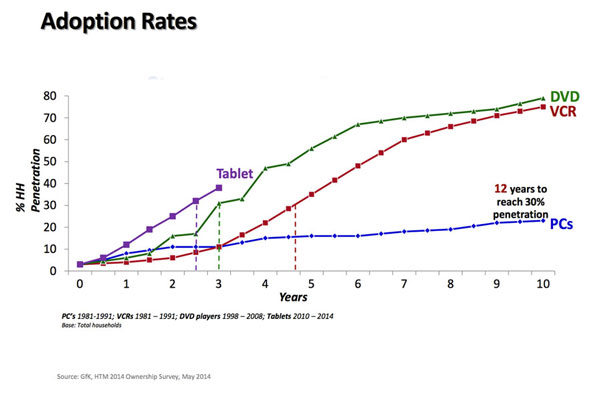
Measuring Up: Where TV Viewers are Going
NBC research head Alan Wurtzel lays the cards of our evolving audience—whom he says clocked 17 million views of NBC programming alone across digital platforms—on the table. This is the first of a 2-part look for Television Academy members at how television watching has changed.
Unlike the simpler the days of yesteryear, there is no clear definition of what exactly constitutes a so-called “hit” series.
So said Alan Wurtzel, President of Research & Media Development for NBCUniversal, to journalists gathered in Beverly Hills, California, for the Television Critics Association’s biannual conference.
How we actually consume television continues to evolve more rapidly. Cell phones, tablets and laptops keep augmenting (or, for some viewers, replacing) the cable and satellite boxes that replaced the proverbial box-top, rabbit ear antennas.
And as online subscription services like Netflix, Amazon and Hulu continue to create new shows at a swift pace, the challenge is trying to out how to measure exactly who is watching.
Just how do you do it?
Early in the current press tour, Nielsen Media Research dropped by, somewhat teasing the new data measurements it will be unveiling to address this growing digital landscape, amongst other new Nielsen technologies.
But nothing along these lines was definitively addressed until Wurtzel stepped up to bat during NBCU’s portion of the tour.
While Wurtzel, like anyone else employed in a similar capacity, does not have any specific answers — or solutions — he did lay the cards on the table, so to speak, with a breakdown of what we face as an industry in a presentation called Managing Change: Understanding Total Audience Viewers.
“I don’t think there’s anybody in this room that would disagree that the media business is undergoing a profound change,” begun Wurtzel, whose opening graphics showed his audience a “typical" family from the 1960s watching television together juxtaposed with a present day, scattered family individually utilizing various sources of technology.
“The problem is that, because we’re all a part of it and because we live it every day, it’s sometimes hard to really appreciate the magnitude of the changes and the magnitude of their impact.”
So just how do you define a hit — or a miss — when we don’t know how to monitor, or even monetize, this rising new digital landscape?
Big Drops in Live TV Tune-In, Bigger
Gains in VOD, Mobile Viewing
Just 5 years ago, as the chart below illustrates, 83 percent of television programs were watched live, according to Wurtzel's research.
Today, his data said, that figure is only 61 percent.
____________________________________________________________
____________________________________________________________
VOD watching is rapidly increasing as technology improves, growing by 23 percent from 2012 to 2013 (see chart below).
Mobile viewing is also rapidly increasing (with 24 percent of the viewers between the ages of 18-64 that NBC surveyed viewing a program via smart phone within the previous week). And streaming is still relevant, accounting for an average of eight hours a month of viewing.
____________________________________________________________
____________________________________________________________
DVR usage, generally thought to expand a program’s total reach, is also on the uptick. Though when a network like NBC points to growth of 12 to 36 percent over the last 5 years via the DVR for a long-running series Law & Order, which Wurtzel mentioned, a veteran show on a decline in the traditional ratings may post gains in DVR percentage due to the smaller margin of comparison.
Once upon a time, a series was measured via diaries to determine what the household rating was.
The arrival of people meter technology to electronically capture all viewing in the late 1980s shifted the focus to demographics.
And overnight data each morning still gives you a sneak peak what other data streams (like Live + Same Day and Live + 7 Day) could look like.
But when you see a low-rated series on NBC like sitcom Parks and Recreation or Parenthood, what you don’t know — and what Nielsen needs to learn how to measure — is that 37 percent of the Park audience and 21 percent of Parenthood’s audience are being watched or consumed on platforms whose numbers we never ever see, according to NBC.
“Last year, there were 17 million digital views of NBC programs across digital platforms; 16 percent on a tablet, 6 on a smartphone, 78 percent on a desktop,” Wurtzel observed.
“This year the consumption of digital views on a tablet doubled, while desktop declined by 30 percent,” he continued. “So this kind of shows you how the world is changing.”
____________________________________________________________
____________________________________________________________
Nielsen has always had a monopoly in the television business as the provider of audience ratings, which are used as the currency for pricing advertising deals and comparing the popularity of shows.
And Nielsen, at any crossroad, has always been perceived by some as late in the game in coming up with any valid solutions. Lack of measurement at present for the growing digital landscape is therefore no surprise.
To gauge exactly what these changes mean, NBC has come up with its own Total Audience Measurement Index (TAMi), which seeks to measure the total viewing of shows on various platforms and not just television.
But while TAMi offers a sneak peak at what could lie ahead, program data remains in house and is not accessible for release.
“The biggest amount of streaming that takes place, 50 percent of it right now, is viewed on a computer, a PC or a lap,” Wurtzel noted.
“Nielsen is not going to measure this until next September,” he said, “so they’re missing 50 percent of the action right away.”
Nielsen at some point will address these issues. It does eventually move forward, though not fast enough for some.
But as consumption continues to transform right now, we must as an industry keep these shifts in mind as we peruse show ratings headlines.
“I am firmly convinced that if I come back and talk to you a year from now, everything, and maybe even some things that we don’t even think about today, will continue to transform, disrupt, and create paradigm shifts,” Wurtzel concluded. This particularly evident, looking over the on-going generational shifts, illustrated below in this chart, which shows the 3 sources of media (in order) individual subjects said they "can't live without."
“What’s needed is a “harmonic metric” that pulls all those disparate metrics together.”
When that will happen, however, remains anyone’s guess.
____________________________________________________________
•
All charts courtesy of Alan Wurtzel/NBC Universal for
TelevisionAcademy.com/Emmys.com only.










